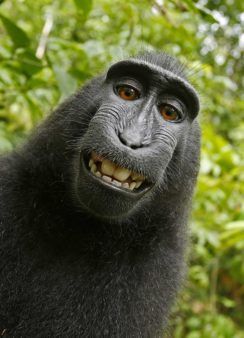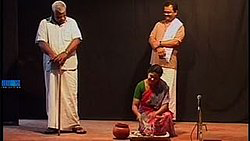Debatable cases on copyright
Monkey selfie copyright dispute

Background
Slater first requested Wikimedia to remove the picture and it was initially removed, but was restored by the editors following a user community discussion. They reasoned that the picture was taken by a monkey and thus belonged to the public domain, as anything created by non-human entities cannot be protected by copyright.
Wikimedia foundation stood its ground by claiming that “copyright cannot vest in non-human authors” and “when a work’s copyright cannot vest in a human, it falls into the public domain.” However, this position hinges on the foundation’s independent assertion that, in the case of Slater’s monkey photos, “no human agent made substantial creative contributions to the final image[s].” Slater, however, asserted that he did make substantial creative contributions.
Slater argued that it was not an accidental “click” by the monkey who chanced upon the camera but instead was a result of a carefully crafted situation by Slater which made it possible for the monkey to capture itself on the camera. Slater further stated that he had made a significant contribution to the creation of the photo through creating an environment that facilitated the shooting of the photo. Because Slater was the only witness to the incident, there is no evidence to support or refute his claims.
Consequence and Insights
This incident has raised significant questions regarding the meaning of “creative contribution” to any piece of work, and on the copyright law that formed the basis of Wikimedia’s actions – work “created” by nonhuman entities is not eligible for copyright protection. Rather than taking this statement literally at its face value, it now seems important to delve deeper into it and ask what it means to create.
This case has compelled experts to rethink about the criteria to qualify for copyright protection. Because copyright laws exist to protect the creative efforts of individuals, we have been forced to delve deeper into the definition of “creative efforts.” James Lorin Silverberg, the director of litigation and founder of the Intellectual Property Group has stated that the author is not necessarily the person who pressed the button that took the picture but rather “the person who really made the creative contribution to the photograph”—the one “to whom the overall appeal of the work owes its origin.”
This incident had a discouraging effect on Slater who seemed dismayed after seeing people legally make money from his work, such as selling T-shirts with the photo printed on it, while he who had put his time and effort into getting the photo was prohibited from receiving any income through it. He had also stated that he wondered if it was even worth being a nature photographer when the laws made life difficult for his profession.
Civic Chandran v. Ammini Amma

Background
‘Ningal Enne Communistakki”, Malayalam for “you made me a communist” is a well known drama written in 1952 by the renowned malayalam playwright Thoppil Bhasi. The drama dealt with the then social and political problems. It had a strong influence on the public and had considerably aided the Communist Party of India to come to power in Kerala in 1957 Assembly elections. Some characters from the play like Mala and Karumpan have become immortal and the play itself has been staged more than 10,000 times and was widely appreciated throughout the state of Kerala. All the rights in publishing and staging the drama were reserved by Thoppil Bhasi till his death and subsequently by the plaintiffs.
In 1995, Civic Chandran published a drama named Ningal Are Communistakki?, malayalam for “Whom did you make a communist?”, in the annual issue of “India Today”(malayalam) magazine. This drama was stylized as a counter-drama to the one written by Bhasi. This drama contained a great amount of similarity with the play by Bhasi, including the characters and dialogues. The plaintiffs claimed that reproducing Bhasi’s drama and distorting it with an intention of attacking the philosophy and ideology of the original drama is an infringement of copyright.
Debate
Chandran has stated that his counter-drama was a new literary innovation “where a play is counter-posed by using the very same theme and characters.” Chandran stated that his play was a criticism against Bhasi himself, and had been written for the purpose of criticism and critical analysis of the original drama. The defense for the counter-drama set up that copying certain elements from the original drama had been done only because the literary technique they used required it.
The plaintiffs argued that Chandran could have used his own characters, dialogues and manner of presentation in the counter-drama. Copying substantial portions of the drama and using the same characters and dialogues cannot be considered as “fair dealing” for the purpose of criticism.
Consequence and Insights
The Kerala High Court in Civic Chandran v. Ammini Amma stated that copying of copyrighted work is permissible if the said work is for a larger public interest. The court added that the amount of content that can be extracted from the original work depends on the circumstances and there can be no clear rule determining the amount.
The court further stated that the counter-drama had been created solely for the purpose of criticism and the scheme of criticism in this case required certain parts of the drama to be reproduced. There has been significant creativity from the side of Chandran in creating the counter-drama and the purpose has been to raise public awareness by criticizing the original, influential drama, rather than monetary.
This case stands out in the history of Indian copyright law as a landmark case on fair dealing where substantial familiarity with the original work was permitted due to the nature of the parody, and because it was for public interest.
References:
-
Can the monkey selfie case teach us anything about copyright law?
-
SULAWESI MONKEY photographs by David J Slater
-
Wikimedia Says When a Monkey Takes a Selfie, No One Owns It
-
Civic Chandran & Others v. C. Ammini Amma & Others | Kerala High Court | Judgment | Law
-
Civic Chandran Case | IIPRD Blog – Intellectual Property Discussions
-
Introduction II. Parody, Copyright Infringement And Fair Use